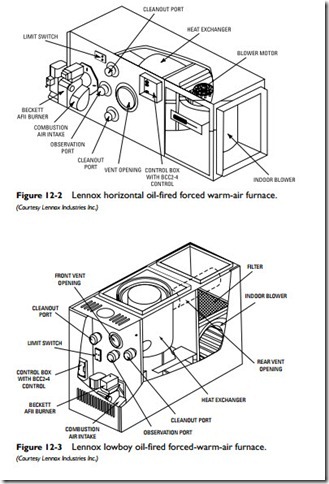Oil furnaces are available in upflow, downflow (counterflow), or horizontal-flow models and in a wide range of heating capacities for installations in attics, basements, closet spaces, or at floor level (Figures 12-1, 12-2, and 12-3). The furnace, oil burner, and controls are generally available from the manufacturer as a complete package for residential installations. All internal wiring is done at the factory.
Oil furnaces should be listed by Underwriters Laboratories, Inc. (UL), for construction and operating safety. Furnaces approved by the agency are marked UL Approved. Furnaces not made under UL standards should not be purchased or installed. Always closely follow the furnace manufacturer’s installation, maintenance, and operating instructions. Note also that any local building codes covering furnace installation will take precedence.
Other sources of information concerning standards for oil furnace selection and installation are the publications Standard for the Installation of Oil Burning Equipment, 2001 Edition (NFPA No.
31) and Installation of Warm Air Heating and Air Conditioning Systems, 2002 Edition (NFPA 90B) from the National Fire Protection Association. See also American Standard Performance Requirements for Oil-Powered Central Furnaces (ANSI Z91.1- 1972), a publication of the American National Standards Institute.
Conventional Oil Furnace
Most residential oil furnaces still in use today are the noncondensing, conventional-types installed before the mid 1980s. Since the 1980s, furnaces installed in new heating systems, and some replacement furnaces, are the newer mid-efficiency and high-efficiency oil furnaces. A conventional oil furnace with a cast-iron head burner has an AFUE (seasonal efficiency rating) of 60 percent.
The heating cycle of a conventional oil furnace begins when the thermostat calls for heat. This is accomplished in one of two ways: (1) The room temperature falls below the heat setting on the thermostat and the thermostat makes an automatic call for heat, or
(2) someone turns the thermostat up manually to a warmer setting. In either case, the call for heat closes an electric circuit to a control relay, and power is sent to both the burner ignition transformer and the fuel pump motor.
The fuel pump motor operates the oil pump, which draws fuel oil from the supply tank and sends it to the nozzle in the gun assembly, where it is combined with the combustion air and atomized. The combustion air is drawn into the combustion chamber by a blower wheel, which is attached to the pump motor shaft. The ignition transformer sends a high-voltage current to the electrodes in the gun assembly to ignite the atomized fuel-oil mixture. The oil furnace heating cycle begins.
As soon as the heating cycle begins, a cadmium selenide photo- cell (called a cad cell) is activated as a safety device. The function of the cad cell is to detect the existence of a flame in the combustion chamber. If the cad cell fails to detect a flame within 15 seconds, the circuit is opened and the burner is shut off.
Some oil furnaces are equipped with a stack relay instead of a cad cell. The stack relay is designed to sense heat. If no heat is sensed, the circuit to the burner is opened and the unit is shut off. In both cases, the heating cycle is interrupted until the problem can be corrected.
As in gas-fired furnaces, a fan and limit control is used to regulate the operation of the furnace blower. The fan switch turns the blower on when there is a call for heat and warm air from the heat exchanger is forced through the heating ducts and into the structure. When the temperature reaches the setting on the thermostat, the fan control shuts off the blower to prevent overheating.

